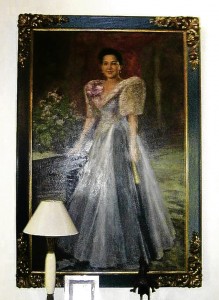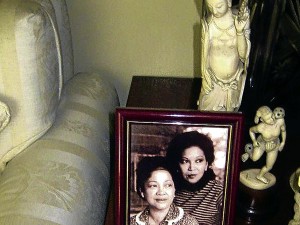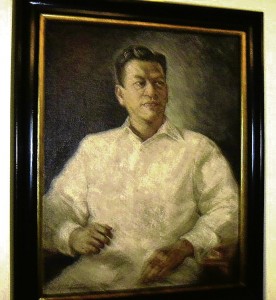President’s daughter who built a career in PR
At a young age, The Manila Peninsula’s retired social and public relations director Mila Magsaysay-Valenzuela worked as a part-time reservations clerk at Pan-American Airways in the 50s.
In the afternoon, after work, she went to school at the University of Santo Tomas where she was then taking up AB political science course.
Her father, Ramon del Fierro Magsaysay Sr., then was President of the Philippines.
“I was a working student,” she begins an almost two-hour interview in her yellow house, formerly ex-President Ramon Magsaysay’s museum (before it was transferred to the Ramon Magsaysay Award Foundation on Roxas Boulevard, Manila), on Fordham street in Wack-Wack subdivision, Greenhills, San Juan, not far from De La Salle where her sons (one is a Lasallian brother) finished high school.
Mila remembers she began to save some money by putting her salary in her bank account. “My father did not have a single bank account. When my father died, he had only P2,000 in his vault.”
Article continues after this advertisementStickler for honesty
Article continues after this advertisementHer father, she says, was scrupulously honest, a stickler for being honest, hard-working and true to one’s character.
“If I would invite my classmates to eat in Malacañang or would celebrate my birthday’s debut there, my father would deduct it to his salary. He would always tell us to use a small car whenever we go to school to save on gasoline for we’re spending the government’s money … When he promised my brother, Jun, that once my brother graduated from high school, he would get him a car, but a second-hand car,” she vividly recalls.
Usually, they would attend mass every Sunday. Her father liked to go to a junk shop in Azcarraga street in Manila, because “he was once a mechanic.” He loved to eat castañas (chestnuts) and would bring them along to a restaurant in Chinatown, Manila for a treat.
“Whenever my dad had a free time, he would call us to his room and he would ask us what did our teachers or classmates say, what’s happening in school, what are the problems. He always had his ears to what people are thinking. He was very mindful of what our countrymen had in mind,” she says.
Later, they would play ping-pong or table tennis. He loved to listen to music while her mother would dance sometimes, she recalls.
There are several occasions, she represented her parents—cutting ribbons, crowning queens in fiestas, standing as a sponsor in baptisms and weddings.

She reiterates that her father never left the Philippines when he was president. He only went abroad twice when he was not yet president: In the US when he was a congressman who worked for the concern of World War II veterans (he was a guerilla leader) and in Mexico and then US again when he was invited by the Lions International as a guest speaker.
During his term as president, however, the US kept inviting him. Then US President Dwight David “Ike” Eisenhower would plan to send Air Force One to pick him up from the Philippines, and there would be a State parade for him, says Mila.
“In the year he died, he finally said yes to President Eisenhower’s invitation. It was election time in the US in 1957. Nakakahiya naman, magpapadala pa ng US Air Force One. That’s how they thought he was very important and how they respected him. He was respected in Asia because he was the one who was able to put down the communist movement,” she says.
March 1957 plane crash
Her father was supposed to be the graduation speaker at UST by the end of March 1957. She would graduate with an AB Political Science degree, and her dad even kidded her that she might be the future mayor of Castillejos, Zambales.
“I have an interest in politics. Politics is government … I’ve an inclination for government service, that’s why I’m an avid watcher of all things happening in our government. I’m not an analyst, but I read most of the columns in the newspapers.”
When she received the news that her father’s C-47 presidential plane, Mt. Pinatubo, was missing, she, together with her mother Luz, sister Teresita and brother Jun, was still hoping because “they’ve not found the wreckage yet. So we’re hoping that he was still alive and just landed in a small island. We’re all praying in the chapel.”
But when it was confirmed that her dad died in a plane crash on March 17, 1957 at Mt. Manunggal, Cebu, her sister Teresita went “ballistic”, considering she was daddy’s girl, being the eldest one. They all cried and found it hard to accept that he was gone suddenly.
During the burial for her dad in Malacañang, she vividly recalls the outpouring of grief among the people. “It was as if people lost a family. Everybody was crying. Everybody wanted to line up, even if the casket was closed. In fact, there was a time we had to close the gate to control the crowd. But they were storming the gate and they wanted to come in. But they were all able to come in, of course … We didn’t realize at first how much people loved him. Millions of people lined up the streets. It was as if not real, it only happened in the movies. We only realized how people loved him as if he were connected to them. That connection was because he loved them back and the communication was really open. My dad got the highest number of votes, almost 70 percent of the votes, considering the voting population then was about 15 million. He was only 46 years old when he became the country’s president.”
House in Singalong
She says her mom proved to be a strong person, but she knew her mother was grieving inside.
“She was only 41 when my dad died. But she had to be strong for us. My dad didn’t have a single bank account, so my mom had to think of ways for us to survive. Though she had little savings in the bank and I had still had a part-time job,” she says.
She reiterates to this journalist that her dad did build them a house in Singalong, contrary to a columnist’s claim in one newspaper, though that lot is now part of La Salle’s College of St. Benilde’s HRM.
“When my father was employed by a bus company in Zambales, the TRY-Tran, he wrote a letter to the manager in the 1930s, borrowing money from the company to be paid by salary deduction. So, he built a house on Arellano street in Singalong, Manila, where it is now a part of La Salle’s College of St. Benilde’s HRM. That’s the only house he built in his lifetime, and we lived there when he was a congressman,” says Mila.
She remembers when her dad became the defense secretary, they lived inside the camp. When her dad was campaigning for the presidency, they lived on Mangga Avenue in Sta. Mesa, Manila in the house of Hans Menzi for free, but later, they moved to the house of the Gabaldons on V. Mapa street, also in Sta. Mesa, Manila for free anew. Then, his father won the presidency and they transferred to Malacañang.
“When we left Malacañang, our house in Singalong was being rented by a Chinese couple for many years, and we don’t want to send them out because they have been a very good tenant of our legal home in Singalong. So, people thought we didn’t have a house. But we had,” she says.
After her father’s death, a friend of her dad offered them to live on Mabini street in Mandaluyong where the Magsaysays stayed for a year for free while “we’re building a bungalow in Wack-Wack.”
Her mother Luz was able to buy a big lot for only P25 per square meter from the Ortigas’s patriarch at that time.
US scholarship
One time while they were having lunch in the house in Mandaluyong, their visitor Francis Joseph Cardinal Spellman, the archbishop of New York, offered Mila a scholarship in Weston, Massachusetts in a school run by the Sisters of St. Joseph to have a taste of American education.
After that scholarship, she went to New York and lived in Long Island with the family’s friend, Francisco Afan Delgado, former Philippine ambassador to the United Nations. “Ambassador Delgado would take me along to the UN … The big thing that time was the Bayanihan Dance Troupe (of the Philippine Women’s University).”
In 1961, she returned to the Philippines. Eventually, she got married to lawyer Cesar Infante Valenzuela, who is the great grandnephew of Pio Valenzuela, a Katipunan leader and an emissary of Andres Bonifacio to Jose Rizal.
They are blessed with three sons, two (Dr. Raphael and Br. Michael) are still alive and one (Gabriel) who died at age 14.
PR Career at The Pen
She reminisces her days at The Manila Peninsula, a respected 5-star hotel located at the corner of Ayala and Makati avenues in the central business district of Makati City and part of The Peninsula Hotels chain based in Hong Kong.
She started to work there in 1976 and she was its public relations and social director for 25 years.
“I have thoroughly loved The Manila Pen. I thoroughly love it now as I did before, and I will do anything for it if needed because I have still the passion for it. It was a very important part of my life and I am proud of it,” says she with alacrity.
So, it was understandable when the management of The Manila Pen sought her help, right after the incident in November 2007. Her PR magic had worked again.
“I have learned so much, and I have met a lot of people that I have become friends with. It’s an experience that when I look back now, I wish I were still there,” says she, who is one of the founders of a PR firm YMV (Ysmael, Moyer, Valenzuela) PR Associates.
She vividly recalls that in the 70s, at first, she was “alien” with her work though she was not strange to a workplace.
She admits that at that time she had to study what public relations is all about. At that time, there were no PR specialists. She had to read books on marketing, advertising and all forms of communication. She had listened to people who are experts and she was eager to learn.
“I found out that you need a technical knowledge, writings and some PR roles, but most of it are common sense and sensitivity to what is happening,” she says.
She reads self-improvement books and also biographies, like the life stories of Max V. Soliven and David T. Boguslav. “I pick up something from the book, even one idea only, then I cross it,” she says.
She says whenever somebody asks her why are PR people women, she replies that “We look at the logic, the details and the big picture. We’re more patient, and mas malambing magsalita kaysa sa mga lalaki. May kaunting cariño.”
And for those who want to practice PR work, she has this piece of advice as she concludes the interview: “It is good to know the technical side of it. It’s good to know the rules. But it is best to have common sense and sensitivity.”

